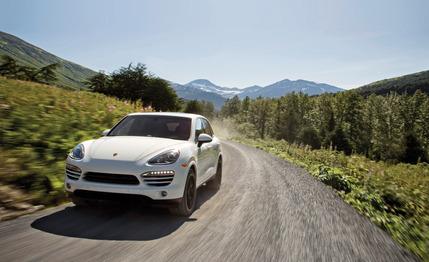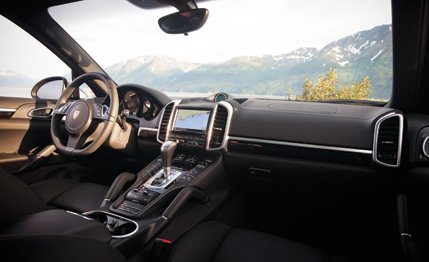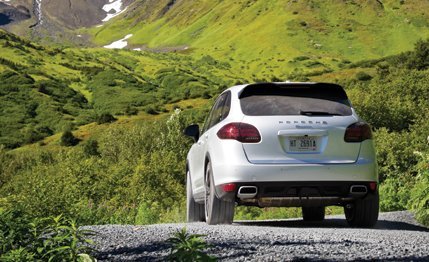
 First Drive Review
First Drive Review
Time for a pop quiz. A diesel-powered Porsche in America is as unlikely as: A) Dodge announcing that it will withdraw from NASCAR following this season; B) Mini introducing yet another variation on its already-ubiquitous theme; or C) 26,942 persons applying for 877 job openings at Hyundai’s Alabama plant last May.
Trick question, ja. All those things have already happened, and so has a diesel-powered Cayenne, which has been sold in Europe since 2009. Its appearance in America is thus no big surprise. For one thing, Porsche marketed a diesel here in the early ’60s, although it was a farm tractor that didn’t catch on. Some five decades later, the company couldn’t resist another diesel, given such easy corporate access to the thing—it’s the turbocharged and intercooled 3.0-liter V-6 that you’ll find in Volkswagen’s Touareg and Audi’s Q7, and, soon, in Audi’s Q5. Which means it will likely appear in Porsche’s upcoming Macan, inasmuch as that SUV will be based on the Q5.
The existing diesel architecture carries over intact, including the variable-geometry turbo and the “compacted graphite iron block,” which saves a claimed 55 pounds over conventional cast iron. It produces 240 horsepower at 4000 rpm and 406 pound-feet of torque at a lowdown-and-dirty 1750 rpm. Speaking of dirty, tucked beneath the spare tire is a 5.5-gallon urea tank good for up to 10,000 miles of low-NOx motoring. If the tank goes dry (after warnings with 1600 and 600 miles of range remaining), the engine will not re-start. Oil changes are mandated every 5000 miles, although Porsche is thinking about upping that interval to match the urea tank’s.


Audi assembles the engine and ships it to Porsche, “but all of the software is unique to us,” says Thomas Herold, manager of Special Operations R&D. In the six-model Cayenne lineup, the diesel carries a sticker of $56,725, propping it $6900 beyond the starter-kit model (a gasoline V-6 with a manual transmission). Porsche expects the diesel to eventually become its bestselling individual model.
We drove this latest Porsche on a 55-degree day in Alaska’s Kenai Peninsula. Never once did we suffer any startup delay. “The glow plugs can reach 1800 degrees [Fahrenheit] in two seconds,” asserts Herold, “so it’s similar to a gas start.” There is no stop-start function offered. “It’s a matter of lubricating the high-pressure fuel pumps,” he adds. “They’re delicate.”
The diesel’s idle hovers around 650 rpm, and both the steering wheel and brake pedal transmit a mild shimmying that isn’t engendered by the gas engines. It’s never intrusive, however. What’s more, there’s virtually no exhaust note, so passengers have no clue they’re aboard an oil-burner. Revs are somewhat slow to climb, and there’s some turbo lag, so it takes a little extra footwork to keep the V-6 stoked. To hustle this Cayenne, you’ll be punching and poking at Porsche’s fussy Tiptronic shifter toggles.
On the other hand, there’s enough oomph at step-off to spill everyone’s frappuccino, and passing power is satisfactory. Overall, the diesel’s reactions to inputs are somewhat leaden, except on the interstate, where it could easily be confused with any other Cayenne. Still, it will take us decades to get over a Porsche with a tachometer that is redlined at 4600 rpm.


We estimate a 0-to-60 time of 7.2 seconds, making the diesel 0.3 second slower than a VW Touareg V-6 TDI and 1.1 seconds quicker than an Audi Q7 TDI—not that diesel SUVs often engage in stoplight combat. Top speed is drag-limited to 135 mph, and it comes in the sixth of this Porsche’s eight gears. The permanent all-wheel-drive system features a self-locking center diff.
Porsche is proud of the diesel’s reduced weight (4800 pounds—or about 450 pounds lighter than a Turbo, by our calculations) and that it is capable of towing 7716 pounds. Fuel-tank capacity is 26.4 gallons, so if this SUV achieves its combined EPA rating of 23 mpg, it will have a range of 607 miles.
“I think the Cayenne diesel is not made for driving hard,” said a German employee who asked not to be named. “It is made for cruising.” In fairness, diesels in heavy SUVs make perfect sense. It’s just that, well, it’s a surpassingly unlikely event for a Porsche stalwart to extol passive cruising. As unlikely as Roger Penske having to dump two famous drivers for behavioral infractions in less than 12 months. Hey, wait a second. That already happened, too.